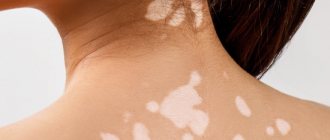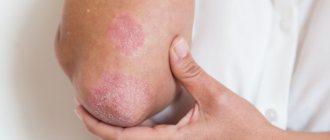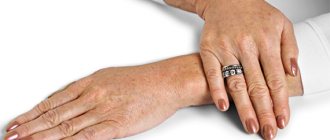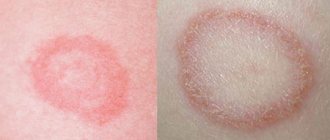Vitiligo is a rare skin disease caused by a deficiency of melanin, the pigment that provides its natural color. With vitiligo, white spots of various sizes appear on a person’s skin. The disease most often affects the skin of the hands, face and legs, which is due to the openness of these areas of the body to direct sunlight.
The disease does not lead to a deterioration in the patient’s general well-being, but causes a feeling of inferiority due to a pronounced cosmetic defect. White spots on the skin attract the attention of others and raise concerns about the contagiousness of the disease.
Areas of skin that lack melanin pigment do not tan in the sun. Moreover, the more actively a person tans, the more noticeable the white spots become.
Causes of vitiligo and risks of its occurrence
The etiology of the disease has not been fully studied by medicine. Presumably, the main factors that can become a trigger for the appearance of this disease are:
- genetic predisposition;
- avitaminosis;
- dysfunction of the endocrine glands;
- complications of viral diseases;
- stress, consequences of severe injuries;
- abuse of ultraviolet rays (love of tanning).
In most cases, vitiligo affects adolescents (15 – 18 years old) and young adults (20 – 30 years old). There is a direct connection between the appearance of the first symptoms of the disease and the action of active sunlight.
There are also a number of risk factors for predisposition to the development of vitiligo. These include:
- autoimmune diseases;
- skin cancer;
- genetic abnormalities.
In patients suffering from vitiligo, 20% of cases in the family had similar cases of the disease, which confirms the importance of genetics in the etiology of vitiligo.
White spots on the skin of children – vitiligo, pityriasis alba
Authors : Christophe HSU, Global Dermatology Information Portal
Typical causes of white spots on the skin of children are: 1) Pityriasis alba 2) Vitiligo
What is “Pityriasis alba”?
- Pityriasis alba is a mild form of dermatitis (skin inflammation).
- This condition is characterized by the appearance of numerous oval, slightly scaly, smooth, hypopigmented (white) patches on the face, arms, and upper torso.
- The boundaries of these spots are unclear.
- The disease occurs in children aged 3 to 16 years; about 30% of children at this age may be susceptible to this disease.
- The spots are not accompanied by itching.
- This disease is often mistaken for a fungal infection (mycosis).
- The condition tends to worsen with exposure to sunlight.
Treatment of pityriasis alba and preventive measures
- This disease is safe. It occurs in cases of hereditary predisposition or against the background of atopic dermatitis. The treatment essentially involves moisturizing the skin.
- The disease can last from several months to several years with a slow spontaneous recovery process.
- Sometimes steroid creams can improve the condition.
- Do not self-medicate.
- Avoid using antifungal creams.
- Limit the use of soap when washing your skin and use detergents that do not contain irritants.
What is vitiligo?
- Vitiligo is the loss of skin pigmentation in certain areas of the skin. These areas of skin appear as smooth white spots with clear contours. The hair in the area of vitiligo spots is often also white.
- There are two types of vitiligo:
- Type A: Vitiligo appears as numerous white patches, widespread and symmetrical. This type of vitiligo most often affects areas of the body such as the limbs, face and neck.
- Type B: Vitiligo appears as localized patches of segmental distribution. This type of vitiligo is most common among children.
- Vitiligo type A tends to spread to other areas of the skin, forming new lesions over time.
- Vitiligo type B tends to spread rapidly and then stop progressing after about one year.
- The causes of vitiligo are not fully known. Among people suffering from vitiligo, the most common cases are diabetes mellitus and thyroid disease.
How is vitiligo treated?
- Your doctor may prescribe one or more of the treatments listed below:
- Topical steroid creams. This method may promote skin repigmentation in some patients.
- PUVA (psoralen + ultraviolet A) is a combination treatment that involves using the drug Psoralen (P) and then exposing the skin to ultraviolet A (UVA). Psoralen can be applied to the skin as a lotion or taken orally in tablet form to increase the skin's sensitivity to ultraviolet rays. Patients undergoing PUVA treatment should be aware that the duration of therapy may be more than a year to achieve optimal results. It is best if this treatment is carried out under the supervision of a dermatologist.
- Concealing cosmetics. Using some cosmetics, you can choose a color that most closely matches your natural skin color. Concealing cosmetics are found to be effective in covering up white spots on the face and back of the hands.
- Sunscreens. Areas of skin affected by vitiligo are prone to sunburn. It is recommended to use sunscreen on affected areas exposed to sunlight.
- Response to treatment may vary across different affected areas of the skin and may vary between patients.
Source
Symptoms of the disease
White spots on the skin of the arms, face and legs, located at the same level as its surface, are the main symptom of vitiligo. At first, the spots look like pale areas of skin, gradually they become lighter until they reach a white color, the blood vessels over such areas of the skin appear pinkish. The border between spots and healthy skin can be different: smooth and bumpy, reddish and brown. It should be noted that vitiligo on the hands is most often located in the wrist area and on the phalanges of the fingers.
Causes and mechanisms
The hands, along with the face, are open areas of the body, and therefore defects in the skin in this area create significant psychological discomfort. But before you worry about a missing or insignificant problem, you need to understand the origin of the phenomenon.
There are two mechanisms involved in the formation of white spots on the palms: decreased pigmentation and microcirculatory changes. The first category includes conditions with so-called leukoderma or local discoloration of the skin, which is based on defects in the accumulation or increased destruction of melanin. A similar symptom can occur with a wide range of pathologies:
- Vitiligo.
- Dermatomycosis (pityriasis versicolor).
- Autoimmune diseases (scleroderma, lupus erythematosus).
- Infectious diseases (syphilis or leprosy).
- Helminthic infestations.
- Endocrinopathies.
White spots can be the result of exposure to chemicals (through professional contact) or occur against the background of certain genetic defects (Ito hypomelanosis). And lighter areas of a microcirculatory nature often appear on the hands of people with vegetative-vascular dystonia. This is precisely the reason we have to deal with in most cases.
The causes of white spots on the hands vary. Leukoderma occurs after skin diseases or in connection with other pathologies, but most often light areas are the result of microcirculatory changes.
Types of Vitiligo
The disease can be segmental or non-segmental. There is also a total type of vitiligo, in which the skin of the entire body is affected. Non-segmental vitiligo occurs in 90% of cases; it is bilaterally symmetrical (located mirror image on the face, both arms, legs in the same places). The size of the depigmented areas approximately corresponds in area to the area of skin from the opposite half of the body.
Non-segmental vitiligo (or localized) is not symmetrical and is located on one part of the body.
Vitiligo: treatment, causes, symptoms - find out everything about the disease from a doctor at the MEDSI clinic
Table of contents
- Causes of vitiligo
- Symptoms of vitiligo
- Diagnosis of the cause of vitiligo
- Treatment methods for vitiligo
- New in treatment
- Advantages of treatment at MEDSI clinics
Vitiligo (leukoderma) is a disease characterized by the loss of natural pigmentation in the skin due to the destruction of melanin. With pathology, certain areas of the dermis become discolored, which makes the cover motley. The disease is acquired and actively progresses over time. Pigment spots on the body that are not treated promptly may increase in size. This is why it is very important to see a doctor as soon as possible.
Causes of vitiligo
The disease usually develops in patients:
- During adolescence
- During menopause
- During pregnancy
The reasons for the development of pathology include prolonged exposure to the sun.
Experts also identify other factors that can cause spots to appear on the skin.
These include:
- Autoimmune diseases
. With such pathologies, the body produces antibodies to its own tissues. The main causes of vitiligo are thyroid disease, rheumatoid arthritis and diabetes. - Genetic predisposition
. If close relatives (fathers, mothers, sisters and brothers) have been diagnosed with vitiligo in the family, the pathology is likely to occur in you too. Interestingly, people with dark eyes most often suffer from the disease. - Neuroendocrine pathologies
. These include both stress conditions and changes in hormonal levels. - Trophic disorders
. Such causes of vitiligo include trauma to the skin and nutritional disorders of the dermis. - Exposure to certain medications
and chemically aggressive substances - Liver pathologies
Symptoms of vitiligo
Vitiligo is manifested by the following symptoms:
- Foci or clear spots
of white (with a milky tint) color - Lack of pigmentation
on the hands, around the ears, eyes, mouth and nose - The presence of clear boundaries
of spots in patients with dark skin
In some cases, the areas above the lips, chin and scalp are affected.
Foci of vitiligo are not the only symptom of the pathology.
Signs of pathology also include:
- Graying or significant lightening of hair in certain areas
- Inflammation of the uvea of the eyes
- Small light spots on the skin
Diagnosis of the cause of vitiligo
Treatment (elimination) of the causes of vitiligo is always carried out only after a thorough diagnosis. It is important to understand that milk spots on the skin are not always symptoms of vitiligo. The pathology is often confused with eczema, dermatitis, lichen, and secondary syphilis.
That is why it is very important to conduct a comprehensive diagnosis. It is based on a careful study of the medical history, since genetic and other factors play a role in the development of vitiligo. Pathology is always preceded by some disease or disorder in the body.
An accurate diagnosis can be made after a biopsy. This diagnostic technique is based on taking a section of skin from both the center and the periphery of the lesion and carefully studying it. During a histological examination, a specialist identifies signs characteristic only of vitiligo (the absence of melanocytes, for example, which produce melanin, which colors the skin).
If other skin diseases are suspected, additional examinations are prescribed. These include blood and urine tests, allergy tests, etc.
Having clarified the cause of the appearance of age spots on the back and other parts of the body, the doctor prescribes treatment. If concomitant pathologies are detected, their therapy is carried out. As a result of successful treatment, the patient completely gets rid of white spots.
Treatment methods for vitiligo
Treatment of vitiligo pigment spots is carried out mainly with medication.
Important! When selecting treatment methods, one should take into account the fact that the pathology affects not only the skin, but also the nervous, endocrine and immune systems.
To eliminate the causes of age spots and treat vitiligo, the following groups of drugs are used:
- Glucorticoids
. These medications are taken to eliminate allergic reactions and inflammatory processes. Patients are prescribed both hormonal ointments and oral medications. The course of treatment usually lasts 3-4 months. Particular attention in therapy is paid to reducing side effects from drugs - Photosensitizing agents
. Thanks to them, the sensitivity of skin cells that produce melanin to ultraviolet radiation increases. After taking the drugs, the skin is irradiated. An ultraviolet lamp is used for this. - Means for eliminating concomitant pathologies
(dermatitis, psoriasis, etc.)
Also, treatment (elimination) of the causes of age spots on the arms, legs, neck and other parts of the body is carried out using:
- Antioxidants that trigger the processes of restoration of valuable substances contained in the skin
- Preparations that replenish the deficiency of certain vitamins, ensuring the maintenance of stable skin color
- Copper
- Immunomodulators that ensure the maintenance of the body’s general protective barrier
New in treatment
Treatment for vitiligo is constantly improving.
Today laser therapy is actively carried out. It is aimed at treating areas of skin without pigmentation with radiation with a wavelength of 308 nm. This therapy allows you to slow down the development of the pathological process, reduce the area of skin damage and restore pigmentation. Excimer laser irradiation is aimed at:
- Improving metabolic processes
- Accelerated melanin production
- Activation of skin cells that produce melanin
When irradiated, only the affected areas are affected. Healthy skin nearby is not damaged. Thanks to this, the procedure has almost no contraindications and is absolutely painless. During treatment, the patient feels only warmth and a slight tingling sensation. Such treatment of vitiligo spots is prohibited only in cases of oncology and pregnancy. The result of therapy is long-term remission. Patients usually forget about the spots for several years. Then the processing can be repeated.
PUVA therapy is also performed. This treatment consists of irradiating the patient with ultraviolet light with a wavelength of 320-390 nm with the preliminary use of a drug that increases susceptibility to it. The procedures are performed in courses, 2-3 sessions per week. PUVA therapy is recommended for patients who have not responded to drug treatment alone and the spots spread over more than 30% of the body surface.
Selective phototherapy is also popular. With this treatment, the patient's skin is irradiated with two types of light rays: medium and long wavelengths. Such rays provide local effects and increase the number of melanocytes. Thanks to this, the destruction of melanin is prevented and the process of formation of new one is started. The course usually includes 30-50 sessions, which are held 3-4 times a week.
To treat white pigment spots on the face, after clarifying the reasons for their appearance, in some cases skin bleaching is performed. It is important to understand that this therapy is aimed only at masking the existing defect. Special medications are used for treatment. Many of them are quite aggressive and have a large number of side effects. In addition, the cost of the funds used is quite high.
The most aggressive treatment method for vitiligo is skin transplantation, which also does not eliminate the causes of the pathology. The method is expensive and traumatic. After surgery, patients often experience complications. In addition, the intervention does not guarantee a lasting effect.
Vitiligo, the treatment of which is carried out professionally and comprehensively, in a specialized medical center by experienced specialists, almost always gives the desired result. This is why we strongly recommend turning to professionals!
Advantages of treatment at MEDSI clinics
Vitiligo treatment in Moscow in our clinics is carried out:
- Experienced professionals. They have all the necessary skills and knowledge to eliminate not only the external manifestations of pathology, but also its causes.
- Only after a thorough visual examination, history taking, biopsy and histology
- Using phototherapy with laser radiation. The Excilite µ system is used for therapy, which is a representative of the latest generation equipment and has already proven itself in European countries
- Painless and safe for the patient, in the shortest possible time and in comfortable conditions
- Using only highly effective comprehensive programs and proven techniques
In order to undergo treatment for vitiligo, just call us at +7 (495) 7-800-500 and make an appointment with a dermatologist. An experienced doctor will determine all the features of the pathology, study the patient’s individual indications and select appropriate methods of treating the disease.
Laser removal of pigment spots
A good method for removing pigment spots of any complexity is laser exposure.
At A Clinic we successfully remove pigment from the surface of the skin using the Fraxel laser. The laser beam penetrates deep into the skin without injuring its outer surface. A laser pulse with a specially tuned wavelength hits the melanin granules under the skin, which heat up. In this case, excess pigmentation is destroyed, but the surrounding tissues are not heated or injured. The doctor treats with a laser only the areas where melanin accumulates (pigment spots themselves), which makes this a targeted procedure. In addition, in the microzones of laser exposure, the regeneration of new structural proteins involved in the renewal of our skin - collagen and elastin - begins. Therefore, the skin of your hands after Fraxel will look noticeably younger - dense and elastic, as in your youth.
Fraxel is the safest way to treat excess pigment. Usually, with a small concentration of pigment spots, one laser treatment procedure is sufficient. However, if pigment spots are age-related, then a course of treatment may be required.
Removing pigment using photorejuvenation
The essence of the technique is to activate restoration processes in tissues, which is achieved using intense pulsed light. During the procedure, a special Ellips Flex device treats each problem area.
During the removal of pigment spots, a cooling gel is applied to the treated surface, and a light pulse is passed through it. This is necessary for the correct exposure of the light beam to the spot. The target for the beam is precisely the pigment melanin. As a result, the pigment spot first darkens and then disappears, and the skin color evens out.
When carrying out such rejuvenation, delicate heating of certain layers of the epidermis with a light beam also occurs. Such heating has a very beneficial effect, as it activates the synthesis of collagen fibers. As a result, the skin becomes more elastic and smooth, thickens, acquires a healthy shade, and wrinkles are smoothed out.










